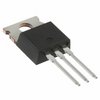Part Details for 2STA1837 by STMicroelectronics
Results Overview of 2STA1837 by STMicroelectronics
- Distributor Offerings: (0 listings)
- Number of FFF Equivalents: (1 replacement)
- CAD Models: (Request Part)
- Number of Functional Equivalents: (5 options)
- Part Data Attributes: (Available)
- Reference Designs: (Not Available)
Tip: Data for a part may vary between manufacturers. You can filter for manufacturers on the top of the page next to the part image and part number.
2STA1837 Information
2STA1837 by STMicroelectronics is a Power Bipolar Transistor.
Power Bipolar Transistors are under the broader part category of Transistors.
A transistor is a small semiconductor device used to amplify, control, or create electrical signals. When selecting a transistor, factors such as voltage, current rating, gain, and power dissipation must be considered, with common types. Read more about Transistors on our Transistors part category page.
Part Details for 2STA1837
2STA1837 CAD Models
2STA1837 Part Data Attributes
|
|
2STA1837
STMicroelectronics
Buy Now
Datasheet
|
Compare Parts:
2STA1837
STMicroelectronics
1A, 230V, PNP, Si, POWER TRANSISTOR, TO-220AB, ROHS COMPLIANT, TO-220FP, 3 PIN
|
| Rohs Code | Yes | |
| Part Life Cycle Code | Obsolete | |
| Ihs Manufacturer | STMICROELECTRONICS | |
| Part Package Code | TO-220AB | |
| Package Description | ROHS COMPLIANT, TO-220FP, 3 PIN | |
| Pin Count | 3 | |
| Reach Compliance Code | not_compliant | |
| ECCN Code | EAR99 | |
| Case Connection | ISOLATED | |
| Collector Current-Max (IC) | 1 A | |
| Collector-Emitter Voltage-Max | 230 V | |
| Configuration | SINGLE | |
| DC Current Gain-Min (hFE) | 100 | |
| JEDEC-95 Code | TO-220AB | |
| JESD-30 Code | R-PSFM-T3 | |
| JESD-609 Code | e3 | |
| Number of Elements | 1 | |
| Number of Terminals | 3 | |
| Operating Temperature-Max | 150 °C | |
| Package Body Material | PLASTIC/EPOXY | |
| Package Shape | RECTANGULAR | |
| Package Style | FLANGE MOUNT | |
| Polarity/Channel Type | PNP | |
| Qualification Status | Not Qualified | |
| Surface Mount | NO | |
| Terminal Finish | MATTE TIN | |
| Terminal Form | THROUGH-HOLE | |
| Terminal Position | SINGLE | |
| Transistor Application | AMPLIFIER | |
| Transistor Element Material | SILICON | |
| Transition Frequency-Nom (fT) | 70 MHz |
Alternate Parts for 2STA1837
This table gives cross-reference parts and alternative options found for 2STA1837. The Form Fit Function (FFF) tab will give you the options that are more likely to serve as direct pin-to-pin alternates or drop-in parts. The Functional Equivalents tab will give you options that are likely to match the same function of 2STA1837, but it may not fit your design. Always verify details of parts you are evaluating, as these parts are offered as suggestions for what you are looking for and are not guaranteed.
| Part Number | Manufacturer | Composite Price | Description | Compare |
|---|---|---|---|---|
| 2SA1837L-TF1-T | Unisonic Technologies Co Ltd | Check for Price | Power Bipolar Transistor, | 2STA1837 vs 2SA1837L-TF1-T |
2STA1837 Frequently Asked Questions (FAQ)
-
STMicroelectronics provides a recommended PCB layout in the application note AN5046, which includes guidelines for thermal pad connection, copper pouring, and via placement to ensure optimal thermal performance.
-
The input capacitor values depend on the input voltage, output voltage, and output current. A general guideline is to use a minimum of 10uF ceramic capacitor with a voltage rating of at least 1.5 times the input voltage. Refer to the application note AN5046 for more detailed guidance.
-
The maximum allowed voltage on the bootstrap pin (BST) during startup is 6V. Exceeding this voltage may damage the device. Ensure that the bootstrap capacitor is properly sized and the voltage is clamped to prevent overvoltage.
-
To ensure proper biasing during startup, connect a resistor (typically 1kΩ to 10kΩ) between the VCC pin and the VIN pin. This helps to establish a stable voltage on the VCC pin before the device starts switching.
-
The recommended frequency range for the 2STA1837 is between 100kHz to 500kHz. Operating outside this range may affect the device's performance, efficiency, and stability.
